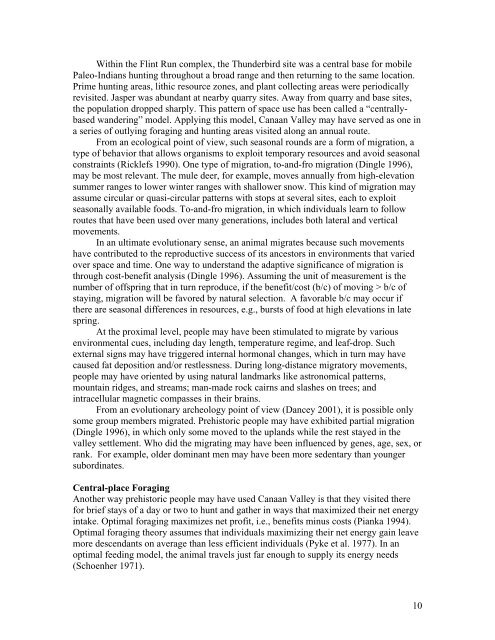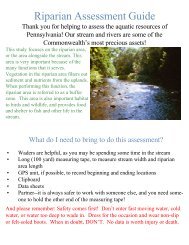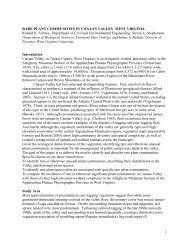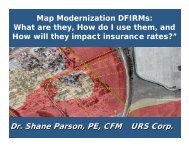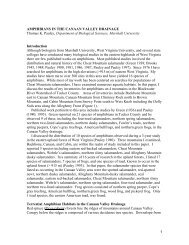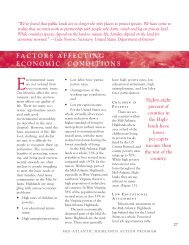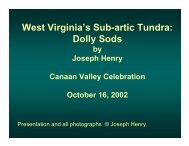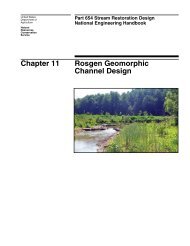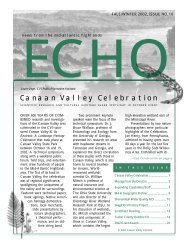1 PREHISTORY OF CANAAN VALLEY: AN ECOLOGICAL VIEW ...
1 PREHISTORY OF CANAAN VALLEY: AN ECOLOGICAL VIEW ...
1 PREHISTORY OF CANAAN VALLEY: AN ECOLOGICAL VIEW ...
You also want an ePaper? Increase the reach of your titles
YUMPU automatically turns print PDFs into web optimized ePapers that Google loves.
Within the Flint Run complex, the Thunderbird site was a central base for mobile<br />
Paleo-Indians hunting throughout a broad range and then returning to the same location.<br />
Prime hunting areas, lithic resource zones, and plant collecting areas were periodically<br />
revisited. Jasper was abundant at nearby quarry sites. Away from quarry and base sites,<br />
the population dropped sharply. This pattern of space use has been called a “centrallybased<br />
wandering” model. Applying this model, Canaan Valley may have served as one in<br />
a series of outlying foraging and hunting areas visited along an annual route.<br />
From an ecological point of view, such seasonal rounds are a form of migration, a<br />
type of behavior that allows organisms to exploit temporary resources and avoid seasonal<br />
constraints (Ricklefs 1990). One type of migration, to-and-fro migration (Dingle 1996),<br />
may be most relevant. The mule deer, for example, moves annually from high-elevation<br />
summer ranges to lower winter ranges with shallower snow. This kind of migration may<br />
assume circular or quasi-circular patterns with stops at several sites, each to exploit<br />
seasonally available foods. To-and-fro migration, in which individuals learn to follow<br />
routes that have been used over many generations, includes both lateral and vertical<br />
movements.<br />
In an ultimate evolutionary sense, an animal migrates because such movements<br />
have contributed to the reproductive success of its ancestors in environments that varied<br />
over space and time. One way to understand the adaptive significance of migration is<br />
through cost-benefit analysis (Dingle 1996). Assuming the unit of measurement is the<br />
number of offspring that in turn reproduce, if the benefit/cost (b/c) of moving > b/c of<br />
staying, migration will be favored by natural selection. A favorable b/c may occur if<br />
there are seasonal differences in resources, e.g., bursts of food at high elevations in late<br />
spring.<br />
At the proximal level, people may have been stimulated to migrate by various<br />
environmental cues, including day length, temperature regime, and leaf-drop. Such<br />
external signs may have triggered internal hormonal changes, which in turn may have<br />
caused fat deposition and/or restlessness. During long-distance migratory movements,<br />
people may have oriented by using natural landmarks like astronomical patterns,<br />
mountain ridges, and streams; man-made rock cairns and slashes on trees; and<br />
intracellular magnetic compasses in their brains.<br />
From an evolutionary archeology point of view (Dancey 2001), it is possible only<br />
some group members migrated. Prehistoric people may have exhibited partial migration<br />
(Dingle 1996), in which only some moved to the uplands while the rest stayed in the<br />
valley settlement. Who did the migrating may have been influenced by genes, age, sex, or<br />
rank. For example, older dominant men may have been more sedentary than younger<br />
subordinates.<br />
Central-place Foraging<br />
Another way prehistoric people may have used Canaan Valley is that they visited there<br />
for brief stays of a day or two to hunt and gather in ways that maximized their net energy<br />
intake. Optimal foraging maximizes net profit, i.e., benefits minus costs (Pianka 1994).<br />
Optimal foraging theory assumes that individuals maximizing their net energy gain leave<br />
more descendants on average than less efficient individuals (Pyke et al. 1977). In an<br />
optimal feeding model, the animal travels just far enough to supply its energy needs<br />
(Schoenher 1971).<br />
10


